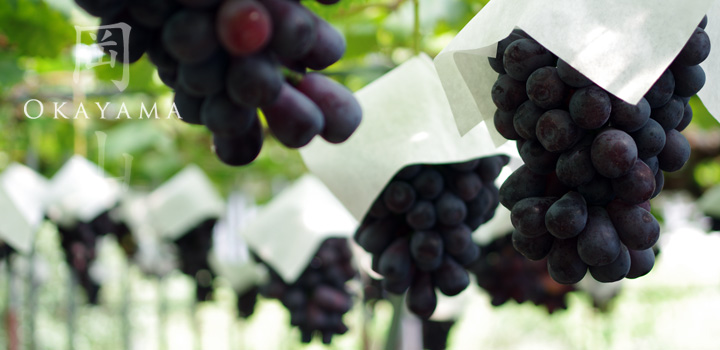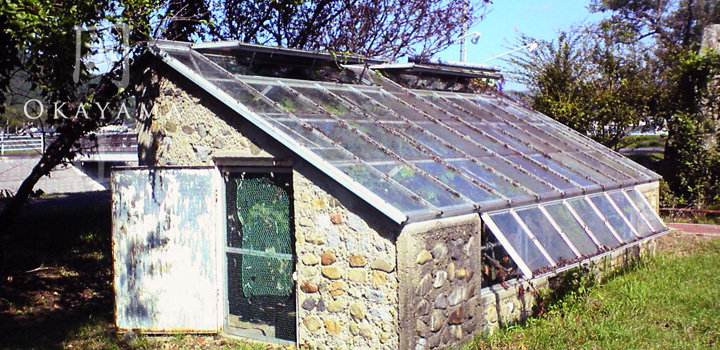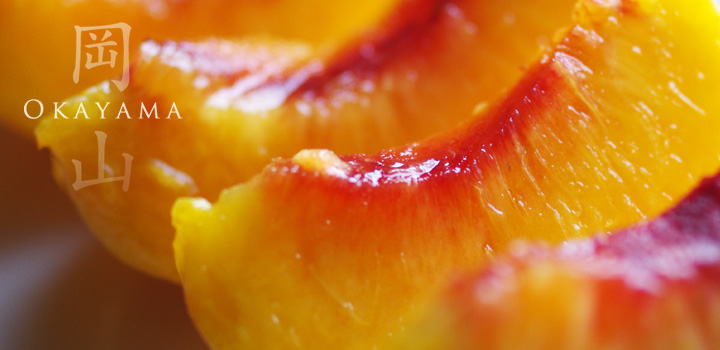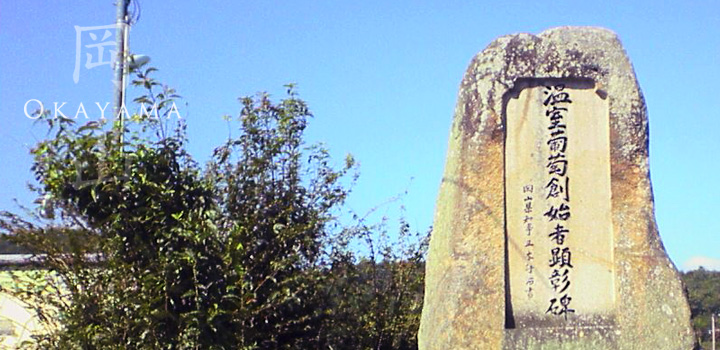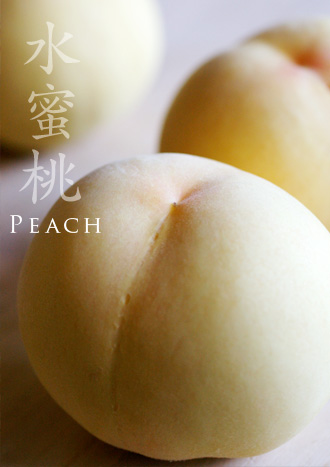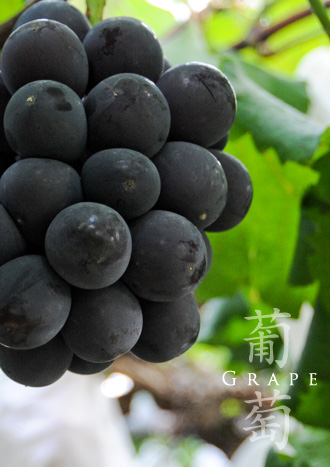More facts about OKAYAMA FRUIT
Let’s go a little deeper into the facts about peaches and grapes produced in OKAYAMA.
We hope to give you a better understanding about OKAYAMA FRUIT, such as its long history and Okayama’s special cultivation techniques. Why are OKAYAMA FRUITS appreciated around the world? How can OKAYAMA manage to maintain its high quality? .. and more!

The history of white peaches all began in OKAYAMA
|
|
In 1875 (Meiji period), peaches from China were introduced to Okayama. |
Distinctive development of OKAYAMA Peach
Did you notice that most of the peaches produced in OKAYAMA are white on the outside? Peaches produced in other parts of Japan are mostly pink or red on the outside. Many people may image the fruit being a pinkish color because the flowers of peaches are pink.
Then why are white peaches being produced in OKAYAMA? Why aren’t they pink?
Delicately and softly
In spring, when the flower buds begin to open, the grape producers pick each bud by hand.
This is to prevent all the nutrition of the tree to be provided to the flowers instead of being sent to the fruit. In doing so, all the nutrition will gather to the fruit. The producers take this procedure for each and every peach tree that covers the whole mountain; imagine all the work! But this is only the beginning…
After fertilization, the fruits grow larger. In accordance with each tree’s situation such as the energy and the strength of the branches, fruit thinning is done as much as necessary. And for the remaining young fruits, each are covered with a small bag.
Of course, all of these procedures are done by hand. No matter how cultivation becomes automated, this is a very delicate process that needs to be handled by the experienced sense of the human hand.
You may wonder – why not let a lot of flowers bloom, then a lot of fruits will grow and without the small bags, you can harvest more fruits and the peaches can grow red. The producers in Okayama do it completely the opposite way.
That’s because they want to produce large, sweet, delicate and tasty peaches; ones that no one else can produce.


That is why they cover each fruit with a small bag – to prevent direct sunlight which makes the texture hard and to protect from insects, rain and strong winds. The bag may be small, but it plays a very important role.
A lot of time, effort, and care are put into the cultivation of the delicate “White Peach” produced in Okayama.
Why are peaches made in Okayama so white?
It’s not because they are unripe. It is the symbol of the producer’s faith to produce the “best peaches in the world” and their “pursuit to producing genuine products that will outclass others”. The skin of the “White Peach” is delicate and soft like a baby’s skin. This is the symbol of world class quality of the “Fruit Kingdom OKAYAMA”.

The beginning of greenhouse cultivation
|
|
Although grapes from Europe were brought to Japan in the early Meiji period, the same time as peaches, it was difficult to produce them in the Japanese climate. Eventually, Mr. Yamauchi, living in Okayama succeeded in producing Muscat of Alexandria in a glasshouse – this is the beginning of the present greenhouse cultivation. |
Grapes being protected in a glasshouse
Greenhouse cultivation has become a standard method to produce grapes in Okayama.
By doing so, they are being produced safe from the rain and wind. And the humidity and temperature are being properly controlled.
We owe it to the time and effort the forgoers spent to create such a system.
There are two categories of grapes; the “European grapevines” that are native to the Middle East and the “North American grapevines” that are native to North America. The North American grapevines are rather easily produced in the Japanese climate. On the other hand, European grapevines are suitable to be produced in a dry area, so they are difficult to produce in the Japanese climate of high temperature and humidity.
Grape producers all around Japan struggled to find a solution, because European grapevines have a superb fragrance, sweetness and plenty of juice; they just couldn’t give up. In time, here in Okayama, glasshouse cultivation began.
With limited space, fruit cultivation in a glass house wasn’t easy.
Handling the leaves, branches and fruit, controlling the temperature, when to water the grapes…after a long process of failure, success and improvement, we now have the greenhouse cultivation in Okayama.One of the famous varieties is the Muscat of Alexandria which has been produced to be as a gift for more than a century; it is now known as “Muscats made in OKAYAMA”.
The grape producers have come a long way; it was a long hard road. That is why they take pride in their work as producers of “high quality grapes in OKAYAMA”. Even now, they are still working hard to improve their technology and selective breeding.
They are hard workers and good developers that never give up on improvement.
Each Bunch is Neatly Shaped - Symbol of Okayama Producers' Pride
Many flower buds of grapes gather to become a bunch. But if they bear fruit naturally, the nutrition scatters. As a result, the flavor also scatters and the grapes become less tasty and beautiful. To avoid this result, when the buds appear the producers trim the bunch. Next, when the fruit starts to bear, thinning is done by imagining the vision of the bunch when it ripens. All of these steps require experienced skills. It is as though the producers are a traditional craftsman.
Delicate, precise experienced skills are an important factor in producing high quality grapes.
Accumulated hard work of the producers by “communicating with trees” is the answer to why OKAYAMA can produce such superb grapes that they take pride in.
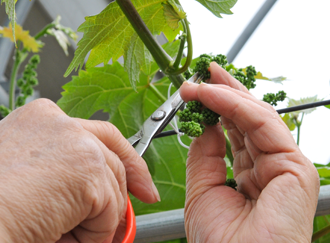
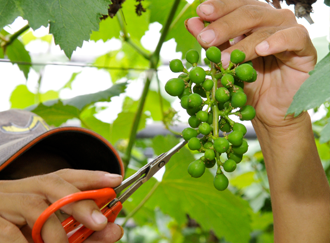
Like peaches, grapes are also covered with small bags to be protected from insects and agricultural chemicals.
Each bunch is carefully hand-covered with a small bag. The quality, beauty and grace safely grow in this bag. All the hard work and care comes from the heart of the producers who take pride in cultivating the “world class grapes of OKAYAMA”.

White powder that covers the grape
Grapes made in Okayama have white powder on them. It may seem as though they are some kind of chemical, but they are not. The white powder is called “bloom grape” or “bloom” and it is a waxy substance that naturally contains in the fruit.
The “bloom” protects the fruit from diseases, rain and moisture loss. It is a natural substance that the fruit itself releases. You can also find them on blueberries, apples and peaches. But it is difficult to spot them on peaches because the skin is white, and they are easily spotted on black grapes (such as New Pione and Aurora Black).
What’s left of the bloom when the grapes are in the markets are a sign of how carefully the grapes were picked and packed. That’s why the producers in Okayama take every precaution not to brush off the bloom when they harvest and pack the grapes.
Other facts about OKAYAMA Grapes
1. The development of seedless New Pione
Recently New Pione are known to be seedless. It was in Okayama where genetically seedless techniques were discovered. They used to call seedless “Pione” grapes “New Pione”, because “Pione” grapes meant they were seeded. But now, most of them are seedless so even if you come across “Pione”, they are probably seedless.
2. OKAYAMA Grapes are oval shaped
Grapes that are produced in other areas are shaped in an inverted triangle. But bunches of grapes that are produced in OKAYAMA are trimmed to ripen in an oval shape, like a rugby ball. Special techniques are required when trimming and it is a result of the “Japanese style sense of beauty”.
3. World-class cultivating techniques
Grapes have been cultivated around the world for over 3000 years. And over the years, grape producers and researchers consider Okayama as the top world-class fresh grape producing area. So many producers and researchers visit Okayama to learn about their techniques and their vision towards cultivating fruits.

